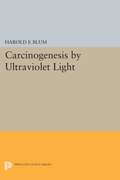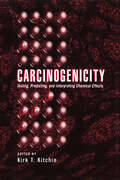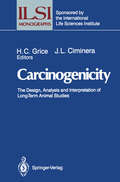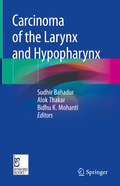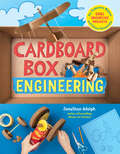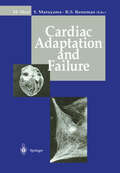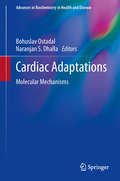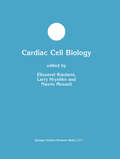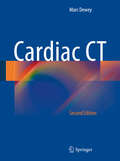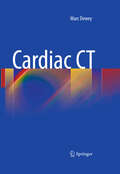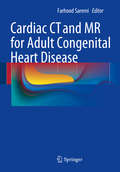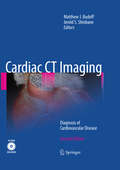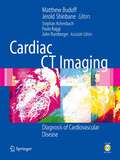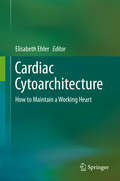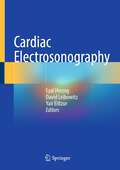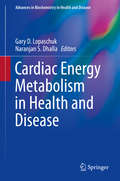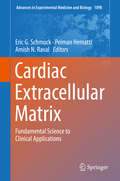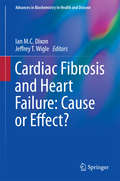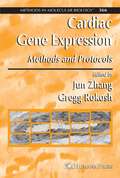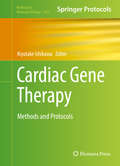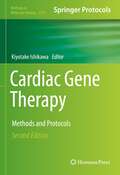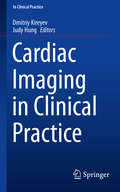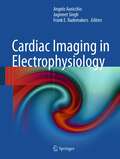- Table View
- List View
Carcinogenesis by Ultraviolet Light (PDF)
by Harold Francis BlumThis book represents the culmination of over fifteen years of experimental and theoretical studies aimed at the elucidation of the process by which ultraviolet light induces cancer. In so far as possible the subject matter is treated from a quantitative point of view, whether dealing with the effects of ultraviolet light on isolated cells or on more integrated systems including the induction of cancer. A description of the course of carcinogenesis by ultraviolet light is presented, based on experimental data, in which cancer is treated as a growing tissue mass. This constitutes probably the most complete summary of a cancer process formulated up to this time.Originally published in 1959.The Princeton Legacy Library uses the latest print-on-demand technology to again make available previously out-of-print books from the distinguished backlist of Princeton University Press. These editions preserve the original texts of these important books while presenting them in durable paperback and hardcover editions. The goal of the Princeton Legacy Library is to vastly increase access to the rich scholarly heritage found in the thousands of books published by Princeton University Press since its founding in 1905.
Carcinogenicity: Testing: Predicting, and Interpreting Chemical Effects
by Kirk T. KitchinOffers comprehensive coverage of currently available cancer predictors, the most recent research on carcinogenicity, and the design and interpretation of carcinogenicity experiments. Presents mouse, rat, and human carcinogenicity data for the liver, kidney, breast, cervix, prostate, hematopoietic system, colon, skin, urinary bladder, mouth, stomach, thyroid, and pancreas.
Carcinogenicity: Testing: Predicting, and Interpreting Chemical Effects
by Kirk T. KitchinOffers comprehensive coverage of currently available cancer predictors, the most recent research on carcinogenicity, and the design and interpretation of carcinogenicity experiments. Presents mouse, rat, and human carcinogenicity data for the liver, kidney, breast, cervix, prostate, hematopoietic system, colon, skin, urinary bladder, mouth, stomach, thyroid, and pancreas.
Carcinogenicity: The Design, Analysis, and Interpretation of Long-Term Animal Studies (ILSI Monographs)
Critical issues in the design, evaluation and interpretation of long-term animal carcinogenicity studies are addressed in this volume. The presentations are by top pathologists, toxicologists and statisticians in the USA, Canada and Europe, representing industry, academia and regulatory agencies. The discussions involve controversial as well as conventional issues and are presented from statistical and biological or toxicological perspectives. Although more work has been done and published on long-term animal carcinogenicity studies than in any other phase of chemical or drug safety assessment, many issues still remain unresolved. Some solutions have been proposed, but in many instances they have not proven to be completely remedial. This volume continues important discussion of these issues and proposed solutions, and should be of interest to scientists engaged in long-term animal carcinogenicity testing.
Carcinoma of the Larynx and Hypopharynx
by Sudhir Bahadur Alok Thakar Bidhu K. MohantiCarcinomas of the larynx and hypopharynx present unique challenges when it comes to their assessment and management. Management involves the essential dilemma of optimizing cure rates while also ensuring that potential disability due to compromised airway, voice and swallowing is minimized. Treatment decisions involve careful disease assessment, judicious multispecialty decision-making, and subsequent meticulous implementation of the selected treatment modalities.The critical nature of each of these steps has led to dramatic advances in assessment techniques (radiology, endoscopy and photography, stroboscopy, narrow band imaging, contact endoscopy) and also in treatment methods (radiation therapy, combined concurrent chemo-radiation, combined sequential chemo-radiation, trans-oral CO2 laser and robotic surgery, partial laryngectomy, total laryngectomy, extended total laryngectomy). As such, treatment decisions have become increasingly complex with the twin objectives of maximizing cure as well as function preservation and are based on tumor stage, tumor location, systemic co-morbidities, nutritional status, patient priorities, and social and economic factors. This multidisciplinary book has been written by a team of editors with considerable experience and expertise in these critical areas and a deep understanding of teamwork and the strengths and limitations of individual technologies and treatments. It presents a homogeneous and unbiased view that is applicable to all specialties involved in the care of larynx and hypopharynx cancers.
Cardboard Box Engineering: Cool, Inventive Projects for Tinkerers, Makers & Future Scientists
by Jonathan AdolphYoung tinkerers and makers will find creative ways to use cardboard boxes, sheets, and tubes in easily-engineered projects, including awesome gadgets, toys, games, inventions, and sculptures.
Cardiac Adaptation and Failure
by Masatsugu Hori Yukio Maruyama Robert S. RenemanAdvances in cellular physiology and molecular biology have now disclosed the metabolic changes and adaptational responses of the heart to various kinds of stresses. Topics covered in this volume include the regulation of myocardial proteins in mechanical overload, the alteration of adrenoceptors in the stressed heart, metabolic adaptation in cardiac hypertrophy, intracellular calcium metabolism in the ischemia-reperfused myocardium, calcium overload as a cause of myocardial stunning, acquisition of ischemic tolerance by ischemic preconditioning, factors that accelerate myocardial injury, and ventricular remodeling in the ischemic heart. As an update of the latest findings in basic cardiology, this book will benefit both researchers and clinical practitioners.
Cardiac Adaptations: Molecular Mechanisms (Advances in Biochemistry in Health and Disease #4)
by Bohuslav Ostadal and Naranjan S. DhallaThis book summarizes present knowledge of different mechanisms involved in the development of positive and negative consequences of cardiac adaptation. Particular attention is paid to the still underestimated adaptive cardiac responses during development, to adaptation to the frequently occurring pressure and volume overload as well as to cardiac changes, induced by enduring exercise and chronic hypoxia. Cardiac Adaptations will be of great value to cardiovascular investigators, who will find this book highly useful in their cardiovascular studies for finding solutions in diverse pathological conditions; it will also appeal to students, fellows, scientists, and clinicians interested in cardiovascular abnormalities.
Cardiac Cell Biology (Developments in Molecular and Cellular Biochemistry #39)
by Elissavet Kardami Larry Hryshko Nasrin MesaeliCardiac cell biology has come of age. Recognition of activated or modified signaling molecules by specific antibodies, new selective inhibitors, and fluorescent fusion tags are but a few of the tools used to dissect signaling pathways and cross-talk mechanisms that may eventually allow rational drug design. Understanding the regulation of cardiac hypertrophy in all its complexity remains a fundamental goal of cardiac research. Since the advancement of adenovirally mediated gene transfer, transfection efficiency is no longer a limiting factor in the study of cardiomyocytes. A limiting factor in considering cell transplantion as a strategy to repair the damaged heart is cell availability at the right time. Cardiac gap junctions, intercellular communication channels that allow electrical and metabolic coupling and play an important role in arrhythmogenesis are now understood to be exquisite sensors of cardiac change. The reports in this volume incLude elegant studies that made use of cutting edge technological advances and many specialized reagents to address these issues.
Cardiac CT
by Marc DeweyCardiac computed tomography (CT) has become a highly accurate diagnostic modality that continues to attract increasing attention. This extensively illustrated book aims to assist the reader in integrating cardiac CT into daily clinical practice, while also reviewing its current technical status and applications. Clear guidance is provided on the performance and interpretation of imaging using the latest technology, which offers greater coverage, better spatial resolution, and faster imaging while also providing functional information about cardiac diseases. The specific features of scanners from all four main vendors, including those that have only recently become available, are presented. Among the wide range of applications and issues discussed are coronary calcium scoring, coronary artery bypass grafts, stents, and anomalies, cardiac valves and function, congenital and acquired heart disease, and radiation exposure. Upcoming clinical uses of cardiac CT, such as hybrid imaging, preparation and follow-up after valve replacement, electrophysiology applications, myocardial perfusion and fractional flow reserve assessment, and plaque imaging, are also explored.
Cardiac CT
by Marc DeweyComputed tomography of the heart has become a highly accurate diagnostic modality that is attracting increasing attention. This extensively illustrated book aims to assist the reader in integrating cardiac CT into daily clinical practice, while also reviewing its current technical status and applications. Clear guidance is provided on the performance and interpretation of imaging using the latest technology, which offers greater coverage, better spatial resolution, and faster imaging. The specific features of scanners from all four main vendors, including those that have only recently become available, are presented. Among the wide range of applications and issues to be discussed are coronary artery bypass grafts, stents, plaques, and anomalies, cardiac valves, congenital and acquired heart disease, and radiation exposure. Upcoming clinical uses of cardiac CT, such as plaque imaging and functional assessment, are also explored.
Cardiac CT and MR for Adult Congenital Heart Disease
by Farhood SaremiThis is the first major textbook to address both computed tomography (CT) and magnetic resonance (MR) cardiac imaging of adults for the diagnosis and treatment of congenital heart disease (CHD). Since the introduction of faster CT scanners, there has been tremendous advancement in the diagnosis of CHD in adults. This is mostly due to the higher spatial resolution of CT compared to MR, which enables radiologists to create more detailed visualizations of cardiac anatomic structures, leading to the discovery of anomalous pathologies often missed by conventional MR imaging. This book is unique in highlighting the advantages of both CT and MR for the diagnosis of CHD in adults, focusing on the complementary collaboration between the two modalities that is possible. Chapters include discussions of case examples, clinical data, MR and CT image findings, and correlative cadaveric pictures. The chapters focus not only on the diagnosis of the primary problem, but also give readers information on visual clues to look for that often reveal associated pathologies. This book appeals primarily to diagnostic and interventional radiologists, as well as cardiologists and interventional cardiologists.
Cardiac CT Imaging: Diagnosis of Cardiovascular Disease
by Matthew J. Budoff Jerold S. ShinbaneCT is an accurate technique for assessing cardiac structure and function, but advances in computing power and scanning technology have resulted in increased popularity. It is useful in evaluating the myocardium, coronary arteries, pulmonary veins, thoracic aorta, pericardium, and cardiac masses; because of this and the speed at which scans can be performed, CT is even more attractive as a cost-effective and integral part of patient evaluation. This book collates all the current knowledge of cardiac CT and presents it in a clinically relevant and practical format appropriate for both cardiologists and radiologists. The images have been supplied by an experienced set of contributing authors and represent the full spectrum of cardiac CT. As increasing numbers have access to cardiac CT scanners, this book provides all the relevant information on this modality. This is an extensive update of the previous edition bringing the reader up-to-date with the immense amount of updated content in the discipline.
Cardiac CT Imaging: Diagnosis of Cardiovascular Disease
by Matthew J. Budoff Jerold S. ShinbaneCT is an accurate technique for assessing cardiac structure and function, but advances in computing power and scanning technology have resulted in increased popularity. It is useful in evaluating the myocardium, coronary arteries, pulmonary veins, thoracic aorta, pericardium, and cardiac masses; because of this and the speed at which scans can be performed, CT is even more attractive as a cost-effective and integral part of patient evaluation. This book collates all the current knowledge of cardiac CT and presents it in a clinically relevant and practical format appropriate for both cardiologists and radiologists. The images have been supplied by an experienced set of contributing authors and represent the full spectrum of cardiac CT. As increasing numbers have access to cardiac CT scanners, this book provides all the relevant information on this modality.
Cardiac cycle
by RnibThis diagram shows a detailed diagram of the heart during the cardiac cycle. There is a key on page 1 showing labels and different texture representing blood. There are arrows on the diagram to show the direction of blood flow.
Cardiac Cytoarchitecture: How to Maintain a Working Heart
by Elisabeth EhlerThis book presents a collection of expert reviews on different subcellular compartments of the cardiomyocyte, addressing fundamental questions such as how these compartments are assembled during development, how they are changed in and by disease and which signaling pathways have been implicated in these processes so far. As such, it offers the first overview of the cell biology of heart disease of its kind, addressing the needs of cell biology students specializing in vascular and cardiac biology, as well as those of cardiologists and researchers in the field of cell biology.
Cardiac Electrosonography
by Eyal Herzog David Leibowitz Yair ElitzurThis book focuses on a new clinical algorithmic approach to acute patient care based on the combination of electrocardiography (ECG) and echocardiography performance and interpretation, now renamed: ECG-sonography or electrosonography. The combination of these two basic skills improves patient management by healthcare providers in the acute setting. ECG is one of the oldest diagnostic tools in evaluating patients with cardiovascular symptoms and multiple and complex criteria for its interpretation have been developed over the past decades. The use of point of care ultrasound based on handheld echocardiography has recently emerged as an important clinical tool, particularly in the emergency department (ED) and intensive care unit. These studies are mainly performed by non-cardiologists including intensivists and ED physicians in addition to the physical exam and standard diagnostic tests such as the chest X-ray and laboratory tests to evaluate patients quickly and efficiently.Cardiac Electrosonography provides a new algorithmic approach to ECG interpretation and a simple tutorial of echocardiography performance and interpretation with a major focus on handheld echocardiography. It includes representative cases of patients presenting to the ED with a specific, acute cardiovascular symptom and demonstrates appropriate use of both ECG and echocardiography to improve patient management and outcome. It therefore represents an essential guide to this hybrid procedure for all practicing and trainee cardiologists and all healthcare professionals who manage these patients.
Cardiac Energy Metabolism in Health and Disease (Advances in Biochemistry in Health and Disease #11)
by Gary D. Lopaschuk Naranjan S. DhallaThe heart has a very high energy demand but very little energy reserves. In order to sustain contractile function, the heart has to continually produce a large amount of ATP. The heart utilizes free fatty acids mainly and carbohydrates to some extent as substrates for making energy and any change in this energy supply can seriously compromise cardiac function. It has emerged that alterations in cardiac energy metabolism are a major contributor to the development of a number of different forms of heart disease. It is also now known that optimizing energy metabolism in the heart is a viable and important approach to treating various forms of heart disease.Cardiac Energy Metabolism in Health and Disease describes the research advances that have been made in understanding what controls cardiac energy metabolism at molecular, transcriptional and physiological levels. It also describes how alterations in energy metabolism contribute to the development of heart dysfunction and how optimization of energy metabolism can be used to treat heart disease. The topics covered include a discussion of the effects of myocardial ischemia, diabetes, obesity, hypertrophy, heart failure, and genetic disorders of mitochondrial oxidative metabolism on cardiac energetics. The treatment of heart disease by optimizing energy metabolism is also discussed, which includes increasing overall energy production as well as increasing the efficiency of energy production and switching energy substrate preference of the heart. This book will be a valuable source of information to graduate students, postdoctoral fellows, and investigators in the field of experimental cardiology as well as biochemists, physiologists, pharmacologists, cardiologists, cardiovascular surgeons and other health professionals.
Cardiac Extracellular Matrix: Fundamental Science to Clinical Applications (Advances in Experimental Medicine and Biology #1098)
by Eric G. Schmuck Peiman Hematti Amish N. RavalThis book on cardiac extracellular matrix (ECM) features three sections, Fundamental Science, Pre-Clinical and Translational Science, and Clinical Applications. In the Fundamental Science section, we will cover the spectrum of basic ECM science from ECM’s role in development, biomechanical properties, cardiac ECM influence of cardiomyocyte biology, pathophysiology of ECM in heart disease, and ECM in tissue engineering. Section two, Preclinical and Translational Science, will discuss cardiac ECM technologies in the clinical pipeline including approaches to ECM as a therapeutic, animal models of cardiac research, tracking and imaging methods of cardiac ECM, and cGMP manufacturing and regulatory considerations for ECM based therapeutics. Finally, the third section, Clinical Applications, will highlight the clinical experience around cardiac ECM including therapeutic strategies targeting scar tissue in the heart, Clinical trial design and regulatory considerations, current human clinical trials in cardiovascular medicine and the role of pharmaceutical and biotech companies in the commercialization of ECM technologies for cardiovascular indications. This book provides a comprehensive review for basic and translational researchers as well as clinical practitioners and those involved in commercialization, regulatory and entrepreneurial activities.
Cardiac Fibrosis and Heart Failure: Cause Or Effect? (Advances in Biochemistry in Health and Disease #13)
by Ian M.C. Dixon Jeffrey T. WigleThe unique biology of cardiac fibroblasts and related cells, such as cardiac myofibroblasts and valvular interstitial cells, distinguish them from other fibroblastic cells, a concept that is only beginning to be widely appreciated. Further, the natural signals that stimulate and inhibit cardiac fibrosis within these cells are not well understood. This volume compiles articles that address the molecular mechanisms that control the synthesis and secretion of the cardiac ECM. The book showcases chapters that highlight discussion of role of Transforming Growth Factor β (TGFβ), an important fibrogenic cytokine and its downstream effectors SMAD in many cardiac diseases. Further, the contributions highlight information to discuss endogenous inhibitors of cardiac fibrosis, as well as advances in tissue engineering specific to matrix in the heart. Finally, discussions of unifying mechanisms of matrix remodeling in valves and myocardium are presented.The mechanisms involved in the stimulation of cardiac fibrosis are not fully understood. In most cases the marginal attenuation of cardiac fibrosis as a result of a given therapy is a beneficial side-effect linked to other primary effects on other cells, especially cardiomyocytes. Very few drugs or agents are known to affect the function and dysfunction of cardiac fibroblasts and myofibroblasts alone. The book helps to translate the information gathered within to allow us to alter the course of fibrogenic events that are typical of cardiac fibrosis, and thereby reduce their burden on the patient and on society itself.
Cardiac Gene Expression: Methods and Protocols (Methods in Molecular Biology #366)
by Jun Zhang and Gregg RokoshThis book presents both cutting-edge and established methods for studying cardiac gene expression. The protocols provide a template for solid research, and cover the process through screening, analysis, characterization, and functional confirmation of novel genes or known genes with a new function. The concluding section of the book highlights methods that facilitate overexpression or cardiac-specific targeted gene deletion.
Cardiac Gene Therapy: Methods and Protocols (Methods in Molecular Biology #1521)
by Kiyotake IshikawaThis detailed book provides methodological information on cardiac gene delivery, from classic to state-of-the-art technologies and techniques. Efficient, cardiac-specific, and safe vectors, as well as refined vector delivery methods, are key for successful cardiac gene transfer and eventually for improving patients’ outcomes. Newer vectors and more efficient vector delivery methods have the potential to dramatically improve gene transduction efficacy, while novel gene manipulation techniques enforce the therapeutic power and broaden disease targets. Written for the highly successful Methods in Molecular Biology series, chapters include introductions to their respective topics, lists of the necessary materials and reagents, step-by-step, readily reproducible laboratory protocols, and tips on troubleshooting and avoiding known pitfalls. Authoritative and practical, Cardiac Gene Therapy: Methods and Protocols serves as a valuable tool for molecular biologists and physiologists in the cardiology field conducting cardiac gene transfer research, which will ultimately lead to further advancements in the vital field.
Cardiac Gene Therapy: Methods and Protocols (Methods in Molecular Biology #2573)
by Kiyotake IshikawaThis second edition volume expands on the previous edition with updated techniques and discussions on topics such as gene suppression, editing, and reprogramming; cardiac gene therapy vectors and promoters; cardiac gene delivery methods; pulmonary hypertension; and patient screening and measuring the efficacy of cardiac gene therapy. Written in the highly successful Methods in Molecular Biology series format, chapters include introductions to their respective topics, lists of the necessary materials and reagents, step-by-step, readily reproducible laboratory protocols, and tips on troubleshooting and avoiding known pitfalls. Cutting-edge and comprehensive, Cardiac Gene Therapy: Methods and Protocols, Second Edition is a valuable tool for researchers in cardiology who are conducting gene therapy research. This book will lead to further advancements and successful clinical translations in the field.
Cardiac Imaging in Clinical Practice (In Clinical Practice)
by Dmitriy Kireyev Judy HungThis book provides a concise guide to echocardiography, SPECT, CT and MRI, including both the basics of cardiac imaging as well as tables of normal/abnormal values and guidelines.With advances in technology, cardiac CT and MRI are becoming more popular but are often limited to larger medical centers. By including the basics of these modalities, this book provides a comprehensive guide for a wide range of medical professionals. As physicians outside of cardiology often do not have sufficient exposure to nuclear stress tests, this book contains SPECT and stress test protocols in order to facilitate decision-making when ordering tests and interpreting results.Cardiac Imaging in Clinical Practice is a quick reference guide and will be useful at multiple levels of training, enabling the book to be used as a basic and advanced reference source. As such, it is appropriate for students, residents, fellows and staff attendings who want a practical and handy reference to the diagnostic options open to them.
Cardiac Imaging in Electrophysiology
by Angelo Auricchio, Jagmeet Singh and Frank E. RademakersCardiac arrhythmias are a major cause of death (7 million cases annually worldwide; 400,000 in the U.S. alone) and disability. Yet, a noninvasive imaging modality to identify patients at risk, provide accurate diagnosis and guide therapy is not yet available in clinical practice. Nevertheless, there are various applications of electrophysiologic imaging in humans from ECG/CT reconstructions, MRI to tissue Doppler investigations that provide supplimentary diagnostic data to the cardiologist. EP laboratories are experiencing an increase in volume, for both diagnostic and interventional electrophysiology studies, including mapping, ablation, and pacemaker implants. The equipment requirements for these procedures are stringent, include positioning capabilities, and dose management. This book is designed to review all of the current imaging methodologies that assist in diagnosis within the electrophysiology department.
